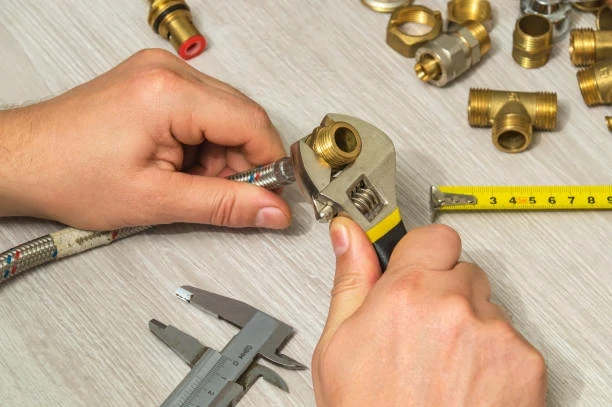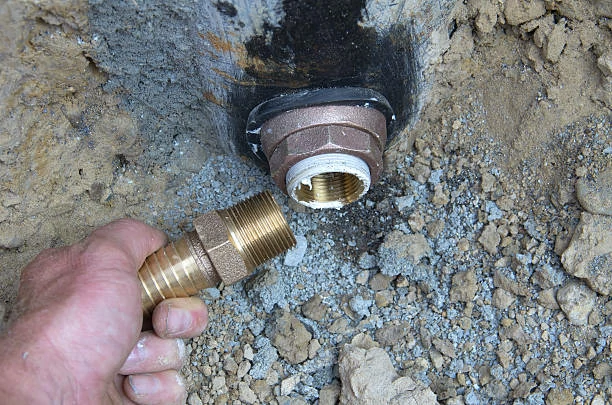PEX (cross-linked polyethylene) plumbing systems have become increasingly popular due to their flexibility, durability, and ease of installation. Moreover, an essential component of any PEX system is the fitting that connects pipes to each other or to fixtures. In fact, there are several types of PEX-connection fitting systems, each with its own advantages, installation methods, and applications. To clarify the differences, this article provides a detailed overview of the most common PEX-connection fitting systems, guiding you in choosing the best option for your plumbing needs.
1. Crimp Fittings
Crimp fittings are one of the most widely used connection systems in PEX plumbing. This system involves sliding a crimp ring (usually made of copper) over the PEX tubing and then inserting a brass or poly (plastic) fitting into the pipe. A crimping tool is used to compress the ring around the tubing, securing the fitting in place.
Advantages:
- Cost-Effective: Crimp fittings are relatively inexpensive and readily available.
- Reliable: When installed correctly, crimp fittings provide a tight, leak-free connection.
- Compatibility: Crimp fittings can be used with all three types of PEX: PEX-A, PEX-B, and PEX-C.
Drawbacks:
- Tool Investment: Special crimping tools are required, which can be costly upfront for DIY homeowners.
- Visual Inspection: The crimp rings need to be visually inspected to ensure they are properly installed, which can be tricky in tight spaces.
2. Clamp (Cinch) Fittings
Clamp fittings closely resemble crimp fittings, but they secure the connection with a stainless steel clamp rather than a copper crimp ring. Installers use a clamping tool to compress the clamp around the PEX tubing.
Advantages:
- Easier Installation: Clamp systems are easier to install than crimp fittings because the tool is more forgiving, requiring less force and precision.
- Durable and Reliable: Like crimp fittings, clamp fittings are durable and create leak-resistant seals.
- Universal Tool: A single tool can be used for various pipe sizes, making it versatile for different installations.
Drawbacks:
- Tool Requirement: Although the tool for clamp fittings is more flexible, it is still an additional cost.
- Possible Leaks: If not properly installed or if the clamp isn’t tightened evenly, the connection may be prone to leaks.

3. Push-to-Connect (Push-Fit) Fittings
Push-to-connect fittings are among the easiest and quickest to install. With these fittings, the PEX pipe is simply pushed into the fitting until it locks in place. Push-to-connect fittings do not require any special tools, making them ideal for quick repairs or when working in tight spaces.
Advantages:
Installers can complete the installation of these fittings in seconds, making them ideal for emergency repairs or time-sensitive projects. Additionally, they offer versatility, as they work with various piping materials, not just PEX, making them a practical choice for mixed plumbing systems.
Drawbacks:
- Higher Cost: Push-to-connect fittings tend to be more expensive than crimp or clamp fittings.
- Size Limitations: These fittings may not be available in as many sizes or configurations as other fitting types.
4. Expansion Fittings
Expansion fittings are most commonly used with PEX-A tubing due to its higher flexibility and memory characteristics. This system involves expanding the PEX tubing using a special expansion tool before inserting a fitting. Once the tubing contracts around the fitting, it creates a secure, watertight seal.
Advantages:
- Strong Seal: Expansion fittings create a secure, leak-proof connection without needing additional rings or clamps.
- PEX-A Compatibility: This method takes full advantage of the flexibility and expansion memory of PEX-A, resulting in stronger connections over time.
- No Restriction: The fitting has a smooth, full-flow design, which minimizes pressure loss and maximizes water flow.
Drawbacks:
- Tool Requirement: An expansion tool is required for installation, and the system is best suited for professionals or experienced DIYers.
- Slower Installation: The expansion process adds an extra step compared to crimp and clamp systems, potentially slowing down the installation.
5. Compression Fittings
Compression fittings, though less commonly used in PEX installations, can still be an effective option. This method involves sliding a compression nut and ring onto the PEX tubing and then tightening it onto a threaded fitting.

Advantages:
- No Special Tools: Compression fittings do not require specialized tools, which can be a benefit for homeowners or contractors looking to avoid tool investment.
- Reliable: When properly installed, compression fittings provide a tight, leak-free seal.
- Versatile: These fittings are often used in situations where PEX needs to be connected to metal pipes or threaded connections.
Drawbacks:
- Time-Consuming: Compression fittings can be more time-consuming to install compared to push-fit or crimp systems.
- Less Common: These fittings are less common in modern PEX plumbing systems, so they may be harder to find and more expensive than crimp or clamp fittings.
6. ProPress (Viega)
Viega’s ProPress system utilizes press fittings with a metal sleeve around the PEX tubing. Installers use a specialized pressing tool to compress the sleeve onto the pipe and fitting, forming a permanent, leak-proof seal.
Advantages:
- Professional System: ProPress is often used in commercial applications due to its reliability and ease of installation.
- Permanent Seal: The press-fit design ensures a permanent, leak-proof connection.
- Reduced Installation Time: The pressing tool speeds up the installation process, especially in larger systems.
Drawbacks:
- High Cost: The fittings and tools required for ProPress systems are significantly more expensive than other PEX-connection systems.
- Specialized: This system is typically used by professionals, making it less accessible for DIY applications.
Conclusion
PEX-connection fitting systems offer a range of solutions depending on the specific requirements of the project. Crimp and clamp fittings are cost-effective and reliable, while push-fit systems provide ease of installation without tools. Expansion fittings take full advantage of PEX-A’s properties, and ProPress is ideal for high-volume commercial applications. Understanding the advantages and limitations of each system can help you make an informed decision for your next plumbing project.
FAQs
1. Can I mix different types of PEX fittings in the same system?
Yes, you can mix different types of PEX fittings in the same system, but it’s essential to ensure they are compatible with the same type of PEX pipe (PEX-A, PEX-B, or PEX-C). Keep in mind that some fittings work better with specific PEX types, so mixing should be done with caution to avoid potential issues.
2. Are PEX fittings reusable after disassembly?
Most PEX fittings, especially push-to-connect fittings, can be reused if they are in good condition. However, crimp and clamp rings are typically one-time-use and must be replaced if removed.
3. How long do PEX fitting systems last?
PEX fittings are designed to last as long as the PEX pipes themselves, which can be upwards of 50 years. The longevity of the fittings will also depend on proper installation and maintenance.
4. What are the temperature limitations of PEX fittings?
PEX fittings, like PEX pipes, can generally handle temperatures ranging from -40°F to 200°F. However, it’s always a good idea to consult the manufacturer’s guidelines, especially for high-temperature applications such as radiant heating.
5. Is PEX suitable for outdoor plumbing applications?
While PEX can be used outdoors, it must be protected from direct sunlight and UV exposure, which can degrade the material. For outdoor applications, it’s best to bury PEX pipes or use a UV-protective coating or covering.